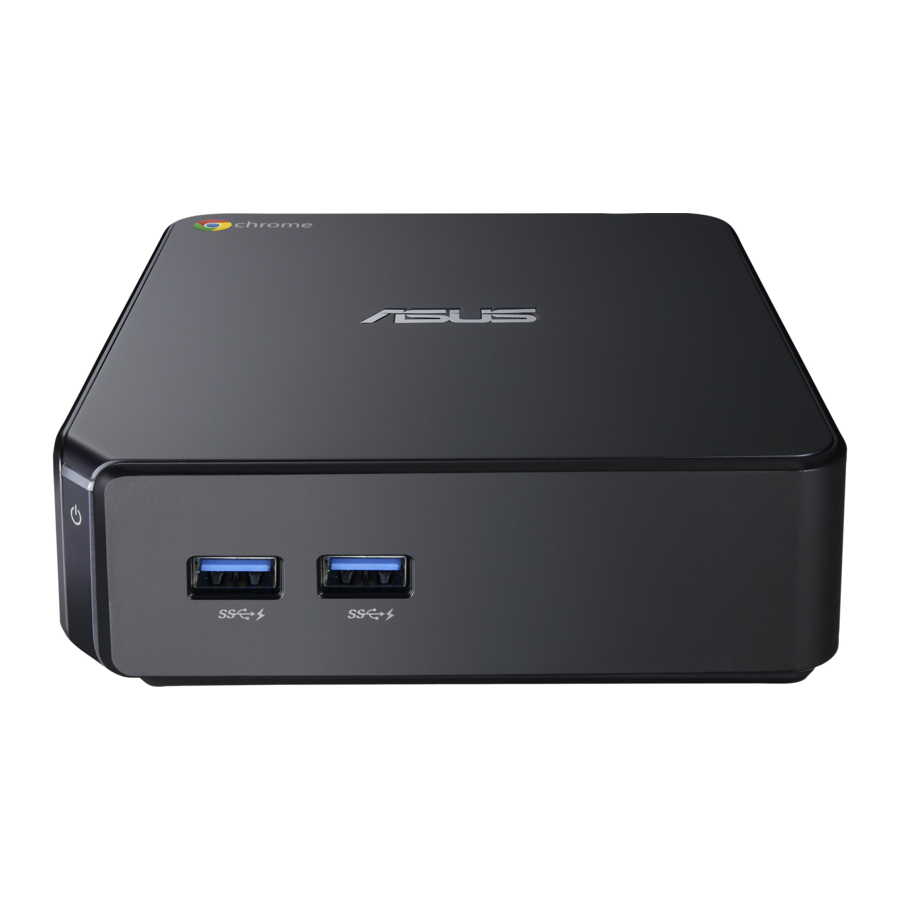
Advertisement

Service Overview
Carefully read through this chapter for a look at various components of the Chromebox and necessary cautions and tools before performing any service and repairs.
To provide the best service and support for the CN60, we have provided the below information for technicians from distributors and resellers to perform the complete VivoPC disassembly and assembly. But before performing the procedures, please be sure to read through the overview in this chapter for component overview, cautions and tools to avoid any unwarranted damages to the VivoPC's hardware.
The following chapter includes:
- Overview
- Service Overview
CN60 Overview
The illustrations below showthe VivoPC'soverview from front view

Please pay special attention to the cautions below to prevent any damages to the VivoPC and also please be sure to select the appropriate tools described in this section to perform any services desired.
Precautions
Before you perform any service and or repair on the VivoPC, please follow the steps below first.
- Be sure that the VivoPC is powered down.
- Disconnect the AC plug from the VivoPC.
- Remove all rings, watches and any other metal objects from your hands.
![]()
- Always wear a ground strap on your hand to protect the VivoPC from static discharge.
![]()
Appropriate Tools
The illustrations below show the appropriate tools that should be used for the VivoPC's service and repair.
Phillips-head Screwdriver
Use a Phillips-head screwdriver to fasten/remove the K- or B-typed screws.

Tweezers
Use a pair of tweezers to remove/ insert flexible cables.

Flat Head Screw Driver

Vacuum Handling Tool

Plastic Blade

Disassembly Caution
ASUS hereby provides a basic instruction for the disassembly of ASUS products, i.e. to remove components and materials that require selective treatments, which are defined by Annex II of the European Union (EU) Waste Electrical and Electronic Equipment (WEEE) Directive 2002/96/EC. This instruction is intended for the use of end-of-life recyclers or treatment facilities. Following is the list of Annex II of EU WEEE Directive 2002/96/EC.
- polychlorinated biphenyls (PCB) containing capacitors in accordance with Council Directive 96/59/EC of 16 September 1996 on the disposal of polychlorinated biphenyls and polychlorinated terphenyls (PCB/PCT),
- mercury containing components, such as switches or backlighting lamps,
- batteries,
- printed circuit boards of mobile phones generally, and of other devices if the surface of the printed circuit board is greater than 10 square centimetres,
- toner cartridges, liquid and pasty, as well as colour toner,
- plastic containing brominated flame retardants,
- asbestos waste and components which contain asbestos,
- cathode ray tubes,
- chlorofluorocarbons (CFC), hydrochlorofluorocarbons (HCFC) or hydrofluorocarbons (HFC), hydrocarbons (HC),
- gas discharge lamps,
- liquid crystal displays (together with their casing where appropriate) of a surface greater than 100 square centimeters and all those back-lighted with gas discharge lamps,
- external electric cables,
- components containing refractory ceramic fibres as described in Commission Directive 97/69/EC of 5 December 1997 adapting to technical progress Council Directive 67/548/EEC relating to the classification, packaging and labelling of dangerous substances,
- components containing radioactive substances with the exception of components that are below the exemption thresholds set in Article 3 of and Annex I to Council Directive 96/29/Euratom of 13 May 1996 laying down basic safety standards for the protection of the health of workers and the general public against the dangers arising from ionising radiation,
- electrolyte capacitors containing substances of concern (height > 25 mm, diameter > 25 mm or proportionately similar volume)
Disassembly Procedure
Please follow the information provided in this section to perform the complete disassembly procedure of the notebook. Be sure to use proper tools described before.
ASUS Chromebox CN60 consists of various modules. This chapter describes the procedures for the complete Chromebox disassembly. In addition, in between procedures, the detailed disassembly procedure of individual modules will be provided for your service needs.
Cover and HDD
The illustrations below show how to remove the Cover and HDD from the VivoPC.
- Remove rubber
![Asus - CN60 - Disassembly Procedure - Cover and HDD - Step 1 Disassembly Procedure - Cover and HDD - Step 1]()
- Remove the bottom cover
![Asus - CN60 - Disassembly Procedure - Cover and HDD - Step 2 Disassembly Procedure - Cover and HDD - Step 2]()
- Motherboard
![Asus - CN60 - Disassembly Procedure - Cover and HDD - Step 3 Disassembly Procedure - Cover and HDD - Step 3]()
- Memory, Wifi Card and SSD
![Asus - CN60 - Disassembly Procedure - Cover and HDD - Step 4 Disassembly Procedure - Cover and HDD - Step 4]()
- Card reader module and cooler system,
![Asus - CN60 - Disassembly Procedure - Cover and HDD - Step 5 Disassembly Procedure - Cover and HDD - Step 5]()
![Asus - CN60 - Disassembly Procedure - Cover and HDD - Step 6 Disassembly Procedure - Cover and HDD - Step 6]()
- Chassis parts
![Asus - CN60 - Disassembly Procedure - Cover and HDD - Step 7 Disassembly Procedure - Cover and HDD - Step 7]()
![Asus - CN60 - Disassembly Procedure - Cover and HDD - Step 8 Disassembly Procedure - Cover and HDD - Step 8]()
- All parts,
![Asus - CN60 - Disassembly Procedure - Cover and HDD - Step 9 Disassembly Procedure - Cover and HDD - Step 9]()
Documents / ResourcesDownload manual
Here you can download full pdf version of manual, it may contain additional safety instructions, warranty information, FCC rules, etc.
Advertisement



























Need help?
Do you have a question about the CN60 and is the answer not in the manual?
Questions and answers